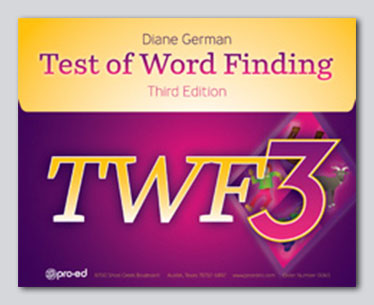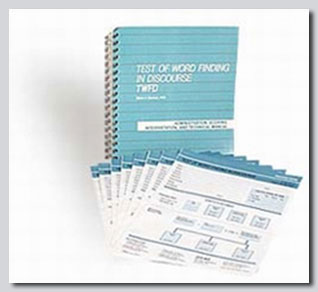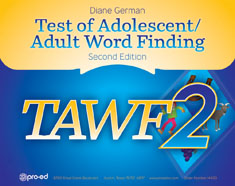|
|||||||||
Word Finding Assessment |
|
|
|||||||
Word Finding Assessment |
 |
The Test of Word Finding-Third Edition (TWF-3) is a nationally standardized, individually administered, diagnostic tool for the assessment of learners’ Word Finding skills. The TWF-3 was developed to be administered to learners 4 years 6 months through 12 years 11 months. Three forms are provided: a pre-primary form for preschool and kindergarten students; a primary form for the first and second grades; and an intermediate form for the third through sixth grades. Learners’ are asked to retrieve nouns and verbs on picture naming and sentence naming tasks. An accuracy index and percentile rank are obtained for each learner. Using the TWF-3, examiners carry out a differential diagnosis of semantic and phonological based word finding error patterns. Three word finding error patterns are considered, Error Pattern 1, Lemma related semantic errors; Error Pattern 2, Form related blocked errors, and Error Pattern 3, Form and segment related phonologic errors. Naming accuracy is measured on noun naming, verb naming and category naming tasks. Knowledge of erred target words is measured using the TWF-3 comprehension assessment. Responsiveness to phonemic cueing is measured using the phonemic cueing procedure. Oral motor skills are checked using a repetition task for each erred multisyllabic word. Target word substitutions are classified as to their semantic and phonological based attributes and secondary characteristics of word finding difficulties are tallied. The TWF-3 is designed to identify learners who have word-finding difficulties, plan word finding intervention, and measure word finding ability in research studies.
|
|
|
The Test of Adolescent/ Adult Word Finding-2nd Edition (TAWF-2) is a nationally standardized, individually administered diagnostic tool for the assessment of adolescent ‘s and adults¹s Word Finding skills. It presents five naming sections: Picture Naming: Nouns; Picture Naming: Verbs; Sentence Completion Naming; Description Naming; and Category Naming. The TAWF includes a sixth comprehension section that allows the examiner to determine if errors are a result of Word Finding problems or are due to poor comprehension. The TAWF provides formal and informal analyses of two dimensions of Word Finding, speed and accuracy. The formal analysis yields standard scores, percentile ranks, and grade standards for item response time. The informal analysis yields secondary characteristics (gestures and extra verbalization) and substitution types. Speed can be measured in actual or estimated item response time.
|
|
 |
The Test of Word Finding in Discourse (TWFD) is a nationally standardized, individually administered diagnostic tool for the assessment of children¹s Word Finding skills in the discourse context. It helps answer important diagnostic questions related to Word Finding difficulties. It is intended to be used with children from ages 6-6 to 12-11 in Grades 1 through 6. The administration time is 15 minutes, and the test can be administered using a standardized (students within norms) or a nonstandardized (students out of norm) procedure. Scores obtained include the Productivity Index, a quantitative measure of how much language is produced in a child¹s discourse, and the Word Finding Behaviors Index, a frequency measure of specific Word Finding behaviors present in a child¹s discourse. Percentile ranks and standard scores can be obtained for both indexes. Informally, the Productivity and Behaviors Indexes are both helpful when describing the nature of students' Word Finding difficulties, as well as when evaluating students' Word Finding difficulties in written language. |
|
This section of
the web site presents the steps for a comprehensive assessment of a
child's Word Finding skills. Below is a description of each of these
assessment steps. Obtaining this information is important in planning
an intervention program for a learner with Word Finding difficulties.
Step 1. Conduct Formal Assessment of Word Finding Using Standardized Tests Developed Specifically to Assess Word Finding It is the in-depth formal diagnostic assessment of Word Finding that provides the specific information needed to develop an individualized Word Finding intervention program. Formal assessment of a student's Word Finding difficulties is implemented by using a norm referenced battery of tests designed specifically to assess Word Finding. These standardized assessments should evaluate a student's retrieval skills in both convergent and divergent retrieval contexts. Assessment of student's convergent retrieval skills consists of single word naming tasks that assess the student's ability to retrieve words that satisfy specific semantic constraints imposed by a context. Assessment of a student's divergent naming skills is completed through an analysis of a narrative generated in response to a stimulus. Available normed referenced tests in Word Finding and their descriptions are described in the next section. Word-Finding Assessment in Single Word Naming Contexts Two normed referenced measures developed to assess a learner's Word Finding skills in single word naming tasks are the Test of Word Finding- Second Edition (TWF-2) (German, 2000) and the Test of Adolescent and Adult Word Finding (TAWF) (German, 1990). These tests require the learner to retrieve target words in several single word naming contexts, using accuracy and response time to define Word Finding difficulties. They provide guidelines for analyzing student response errors, and include a comprehension assessment of target words that were named incorrectly. The latter assessment helps examiners differentiate between students whose naming errors are due to general vocabulary deficits from those students who have Word Finding problems in the presence of good comprehension of the target word. Word Finding Assessment in Discourse Although Word Finding assessment has focused primarily on single word naming contexts (convergent naming), it is also important to evaluate student's Word Finding skills in the discourse context. In an analysis of a student's Word Finding skills in discourse, examiners focus on the student's language productivity and the incidence of Word Finding behaviors in their narratives (German, 1987, German & Simon, 1991). The Test of Word finding in Discourse (German, 1991) assesses children's Word Finding skills in narratives. Step 2. Assess Student's Word Knowledge An assessment of a student's Word Finding abilities is primarily an evaluation of the student's oral language skills. However, it is critical to differentiate between vocabulary difficulties that are due to difficulties in learning meanings and building semantic networks and vocabulary difficulties that are due to word retrieval problems. Assessing a student's word knowledge can help in this differential diagnosis. Therefore, a measure of a student's word knowledge should be part of the evaluation to identify Word Finding difficulties. Step
3. Follow Up with Informal Assessment Procedures and Diagnostic
Teaching |
||
|
